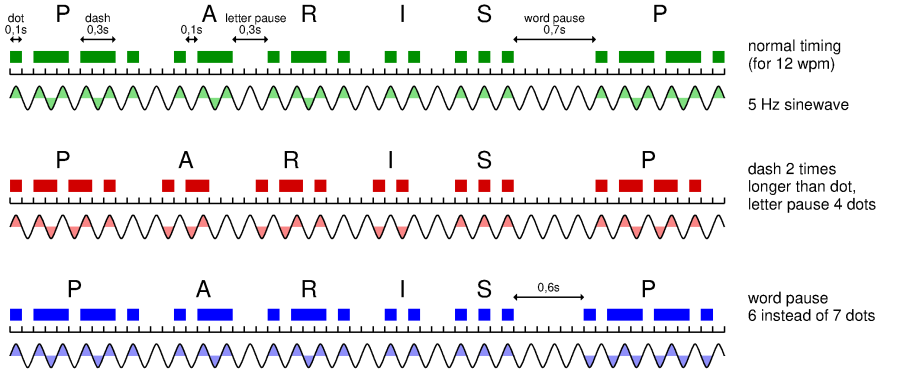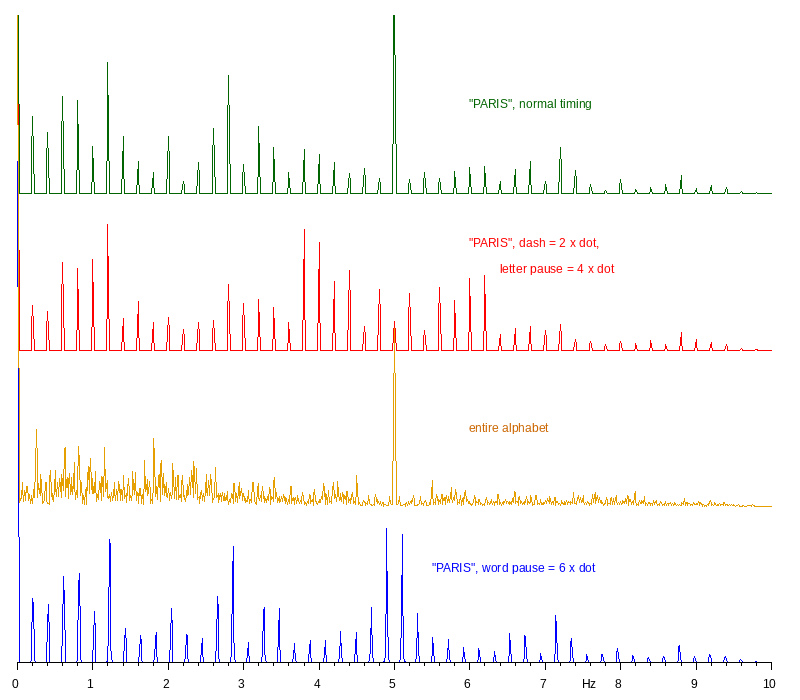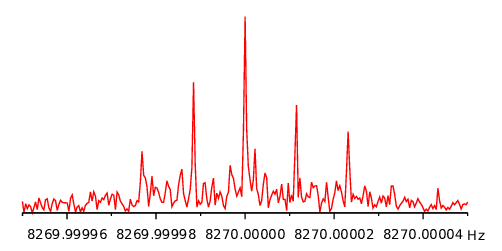Timing of morse code
Pieter-Tjerk de Boer, PA3FWM web@pa3fwm.nl(This is an adapted version of part of an article I wrote for the Dutch amateur radio magazine Electron, July 2022.)
As is well-known, morse code messages are built from `dots' and `dashes', or, keying up the transmitter during a short or a longer time. Officially, a dash is three times as long as a dot, and there are also rules for the pauses in between: the pause within a letter is as long as a dot; the pause between two letters is three times as long, and the pause between two words is seven times as long as a dot. Hand-keyed morse (and definitely mine) may easily deviate from this official timing; but in the sequel I'll assume the timing is perfect, e.g. due to being sent by a machine.
 The figure shows at the top an example of perfectly timed morse code, in this case the word PARIS.
This word, including the space at the end, has a duration of exactly 50 units of time, each as long as a dot,
and is generally used to define the speed in words per minute (wpm).
In the figure, a dot is 0.1 s; so PARIS takes 5.0 s and fits 12 times in a minute, meaning the speed is 12 wpm.
The figure shows at the top an example of perfectly timed morse code, in this case the word PARIS.
This word, including the space at the end, has a duration of exactly 50 units of time, each as long as a dot,
and is generally used to define the speed in words per minute (wpm).
In the figure, a dot is 0.1 s; so PARIS takes 5.0 s and fits 12 times in a minute, meaning the speed is 12 wpm.
Below the morse signs I've drawn a 5 Hz sinewave. This is the frequency one would get if one were continuously sending 12 wpm dots (with a dot-pause in between). Comparing this sinewave with the morse pattern, one notes that each dot in the morse pattern coincides with a peak of the sinewave. And each dash covers two peaks and one trough, never the other way around.
The fact that the 5 Hz peaks coincide with the dots is a direct consequence of the morse timing rules. For comparison, the second (red) morse signal in the figure has a non-standard timing: the dashes are as long as 2 dots rather than 3, and the pauses between letters are 4 rather than 3. We see that then the dots sometimes coincide with the peaks and sometimes with the troughs.
Another way of understanding this, is by not considering the morse signal as a sequence of dots, dashes and pauses, but as a sequence of three combinations: on-off, on-on, and off-off. Each of these combinations is as long as two dots, and we can compose any morse message with them. A dot in a morse letter, including the minimal possible pause following it, is on-off; a dash is on-on followed by on-off (i.e., three times on followed by one time off); a letter pause is off-off (together with the off at the end of the preceding dot or dash this makes 3 offs in a row), and similarly the word pause is three times off-off. Each combination on-off, on-on or off-off takes as long as one period of the 5 Hz sinewave. Note that we don't need the fourth possible combination, off-on: as a consequence, it never happens that the morse signal during a peak of the sinewave is off but it is on during the subsequent trough.
Spectrum
 Let's have a look at the spectrum of these morse signals in the next figure.
The top, green line is the spectrum of the first signal from the previous figures: repeatedly sending PARIS at 12 wpm and perfect timing.
We see a strong peak at 5 Hz.
That was to be expected, as in the above we had already `recognized' the 5 Hz in the morse signal.
Let's have a look at the spectrum of these morse signals in the next figure.
The top, green line is the spectrum of the first signal from the previous figures: repeatedly sending PARIS at 12 wpm and perfect timing.
We see a strong peak at 5 Hz.
That was to be expected, as in the above we had already `recognized' the 5 Hz in the morse signal.
The second (red) line is the spectrum of the second signal from the previous figure, i.e., again PARIS but with non-standard timing. The 5 Hz peak in the spectrum is now very weak.
In both the green and the red spectrum we see many other peaks, all at multiples of 0.2 Hz. This is due to the entire message PARIS being repeated every 5 seconds, so all spectral components must be multiples of 1/5 Hz. For comparison, the third, yellow line shows the spectrum of sending the entire alphabet (with some spaces), again at 12 wpm. The strong component at 5 Hz is present again, but because the text is now much less regular and does not contain a clear repetition, the rest of the spectrum is now smeared out, without clear peaks.
At other keying speeds than 12 wpm the frequency of the peak of course changes along: divide the speed in wpm by 2.4 to find the frequency in Hz.
Non-standard word pause
We still didn't disuss the last, blue, line in the first figure. This is again PARIS, but now sent with a timing that deviates from the standard in only aspect: the pause between two words is 6 dots rather than 7. Comparing this with the 5 Hz sine wave, we see that during the first word the dots still coincide with the peaks of the sinewave, but in the second word (of which only the first letter is shown), the dots coincide with the troughs. This alternation continues: at every word pause the morse signal `slips' w.r.t. the 5 Hz sinewave.This has a rather characteristic consequence for the spectrum, as can be seen in the last (blue) line in the second figure. The peak at 5 Hz is now gone; instead, there are now two peaks, at 4.9 and 5.1 Hz. One can interpret them as modulation sidebands: our 5 Hz sinewave is now 180-degree phase modulated by a 0.1 Hz square wave (namely alternating between 5 seconds one phase, and 5 seconds the opposite phase).
Playing detective
Such an analysis of the spectrum can be useful to identify a signal in cases where one, for whatever reason, does not have more detailed information. For example if the signal is too weak to recognize individual morse characters, or if all you have is a spectrum diagram.That situation happened in early 2022, when PA0EHG published a spectrum plot that you can find at [6]. It shows two signals. The first is a morse beacon operated by PA0RYL on 3555.5555 kHz, keying at 8 wpm; the strong peak at 8 / 2.4 = 3.33 Hz is clearly visible. The second signal's provenance was unknown; perhaps PA0RYL again, but then with an unusual propagation mechanism. However, the second signal does not have a strong component at 3.33 Hz. It does have strong components at 11.0 and 11.3 Hz. For a morse signal, that would hint at 11 × 2.4 = 26.4 wpm. According to reversebeacon.net, OM5CM sent CQ around that time, at that speed, and on approximately this frequency, so it might be him. But why would there be a double peak at 11.0 and 11.3 Hz? Well, OM5CM kindly sent me a recording of his CQ. From that it turned out that his keyer uses a word pause of 6 rather than 7 dots; as we've seen above, this causes the peak in the spectrum to be split. The fact that the peak is indeed split in the received signal, supports the hypothesis that the signal was indeed from OM5CM (even though we'll never be 100 % sure).
Why is the morse timing like this?
![fragment from the 1865 ITU conference record [1]](tn31fig3.png) The morse alphabet has a long history, going back to far before the invention of radio,
namely the 1830s, when it was designed for use in cable telegraphy.
For international telegraphy, the current alphabet and timing rules were established
at the first ITU (International Telecommuncattions Union) conference in 1865.
Surprisingly, the conference record [1] says the word space is as long as 4 (`quatre') dots.
I think the intention was that these 4 dots should be added on top of the letter space of 3 dots,
making the total 7 as we know from later ITU publications [2].
The morse alphabet has a long history, going back to far before the invention of radio,
namely the 1830s, when it was designed for use in cable telegraphy.
For international telegraphy, the current alphabet and timing rules were established
at the first ITU (International Telecommuncattions Union) conference in 1865.
Surprisingly, the conference record [1] says the word space is as long as 4 (`quatre') dots.
I think the intention was that these 4 dots should be added on top of the letter space of 3 dots,
making the total 7 as we know from later ITU publications [2].
![fragment from Gerke's book [2]](tn31fig4.png) But of course the ITU did not invent this alphabet on the spot.
They based it on work by Clemens Gerke from Germany.
In a book [3] from 1851, he compares different morse alphabets in terms of the average length of the letters.
In that book, he calculates as if a dash takes twice as much time as a dot.
If we assume that the short pauses within a letter are as long as a dot,
then this matches the ITU timing: dash plus short pause is twice as long as dot plus short pause.
Gerke writes that that factor 2 is `indeed the rule', ad also notes that `in practice
is is usual to take a bit more'.
The figure shows a part from his book in beautiful (but for us often hard to read) gothic letters.
But of course the ITU did not invent this alphabet on the spot.
They based it on work by Clemens Gerke from Germany.
In a book [3] from 1851, he compares different morse alphabets in terms of the average length of the letters.
In that book, he calculates as if a dash takes twice as much time as a dot.
If we assume that the short pauses within a letter are as long as a dot,
then this matches the ITU timing: dash plus short pause is twice as long as dot plus short pause.
Gerke writes that that factor 2 is `indeed the rule', ad also notes that `in practice
is is usual to take a bit more'.
The figure shows a part from his book in beautiful (but for us often hard to read) gothic letters.
Still, the question remains whether it's a coincidence that the timing of international morse code has such a strong spectral component. Presumably, noone in 1865 considered applying Fourier transforms to morse signals. But there may be another reason. N0HFF writes in [4] that the international morse code has a clear regular rhythm, in contrast to the American morse code (see below). That regular rhythm may very well be how the human brain experiences that strong spectral component (the rhythm of the dots). So perhaps the choices for the timing were made (or came to be) due to the resulting pleasing rhythm?
American morse code
Besides the ITU international morse alphabet, another alphabet has been in use into the 20th century. This alphabet was used in America on the wired telegraph lines, and in the early days of radio also for domestic radio traffic. American radio amateurs in those days thus had to master two morse alphabets! [5]A unique property of the American alphabet is that within a letter there are not just dots, dashes and 1-dot pauses, but also extra long dashes and slightly longer pauses. Particularly the latter are confusing: one must watch out for the difference between such a pause within a letter and the normal (but slightly longer) pause between letters. For this alphabet there seems to be no fixed rule about the ratio of the duration of a dash to a dot: most sources say 3 times as long (like in the ITU morse code), but some say 2. N0HFF suggests [4] that in practice, the timing was adapted to circumstances, e.g. by using a somewhat longer pause after a letter which contains a pause itself, to emphasize the difference.
![American morse recording [7]](tn31fig5.png) A recording of an American morse code radio transmission from 1910 has been preserved,
apparently recorded on a wax cylinder [7].
The figure shows a part of that recording as a graph, with the transcription as letters.
We see a few letters that are identical to the international alphabet (A, G, D and E),
but also two examples of letters that are different: the O, consisting of two dots with
a lengthened pause in between, and the L, consisting of an extra long dash.
Note how small the difference is between the pause inside the O, and between both Os:
two Os can easily be confused with two Is or a single H.
I had hoped to derive from this recording the ratio between dot and dash,
but the pattern is so irregular that no conclusion can be drawn.
In fact, it's so irregular that I wasn't able to decipher it without the transcription
that was fortunately included on [7].
I don't know whether those American operators were so skilled that they could decipher this,
or that such a wax cylinder recording is simply less stable than what we are used to in the SDR era...
A recording of an American morse code radio transmission from 1910 has been preserved,
apparently recorded on a wax cylinder [7].
The figure shows a part of that recording as a graph, with the transcription as letters.
We see a few letters that are identical to the international alphabet (A, G, D and E),
but also two examples of letters that are different: the O, consisting of two dots with
a lengthened pause in between, and the L, consisting of an extra long dash.
Note how small the difference is between the pause inside the O, and between both Os:
two Os can easily be confused with two Is or a single H.
I had hoped to derive from this recording the ratio between dot and dash,
but the pattern is so irregular that no conclusion can be drawn.
In fact, it's so irregular that I wasn't able to decipher it without the transcription
that was fortunately included on [7].
I don't know whether those American operators were so skilled that they could decipher this,
or that such a wax cylinder recording is simply less stable than what we are used to in the SDR era...
Patience is a virtue...
 For the waterfall display in usual SDR software, FFTs are calculated over about a tenth of
a second of signal, leading to a frequency resolution on the order of 10 Hz and about 10 updates
per second.
That suffices to see e.g. the individual dots and dashes of a morse signal.
In the spectrum diagrams of the second figure on this page, and in [6],
each FFT covers several tens of seconds. Such a long FFT gives more frequency resolution,
but less detail in time: the individual dots and dashes are no longer visible,
but the morse timing details show up in the frequency domain.
For the waterfall display in usual SDR software, FFTs are calculated over about a tenth of
a second of signal, leading to a frequency resolution on the order of 10 Hz and about 10 updates
per second.
That suffices to see e.g. the individual dots and dashes of a morse signal.
In the spectrum diagrams of the second figure on this page, and in [6],
each FFT covers several tens of seconds. Such a long FFT gives more frequency resolution,
but less detail in time: the individual dots and dashes are no longer visible,
but the morse timing details show up in the frequency domain.
Sometimes it is useful to determine the spectrum over a still much longer duration. An extreme example is shown in this figure. This is the spectrum of the entire month(!) of December 2021 on 8270 Hz (not kHz!). Already since early 2021 VO1NA has been transmitting an unmodulated carrier on this frequency, and the figure shows the spectrum as received by DL0AO. We see a peak at a distance of 0.0000116 Hz on either side of the carrier. That seems an odd number, but it is 1/86400 Hz. One day comprises 86400 seconds, so that sideband has a frequency of 1 period per day. This `modulation' is produced by the day/night variation of the VLF propagation. The left and right peaks are not equally strong. That may happen if there is both amplitude and phase modulation, which is indeed plausible here. The amplitude modulation is a variation of the strength (VLF signals are less attenuated at night than during the day), and the phase modulation may be caused by variation of the height of the ionosphere, causing the path length the vary.
References
[1] Réglement de service international, Documents diplomatiques de la conférence télégraphique internationale de Paris. 1865
[2] Recommendation ITU-R M.1677-1 (10/2009)
[3] Fr. Clemens Gerke: Der praktische Telegraphist, oder die elektro-magnetische Telegraphie nach dem Morse'schen System. 1851.
[4] William G. Pierpont N0HFF: The Art & Skill of Radio-Telegraphy, chapters 19 and 20. Online on http://www.zerobeat.net/tasrt/.
[5] Alfred Powell Morgan: Wireless Telegraph Construction For Amateurs, 1914.